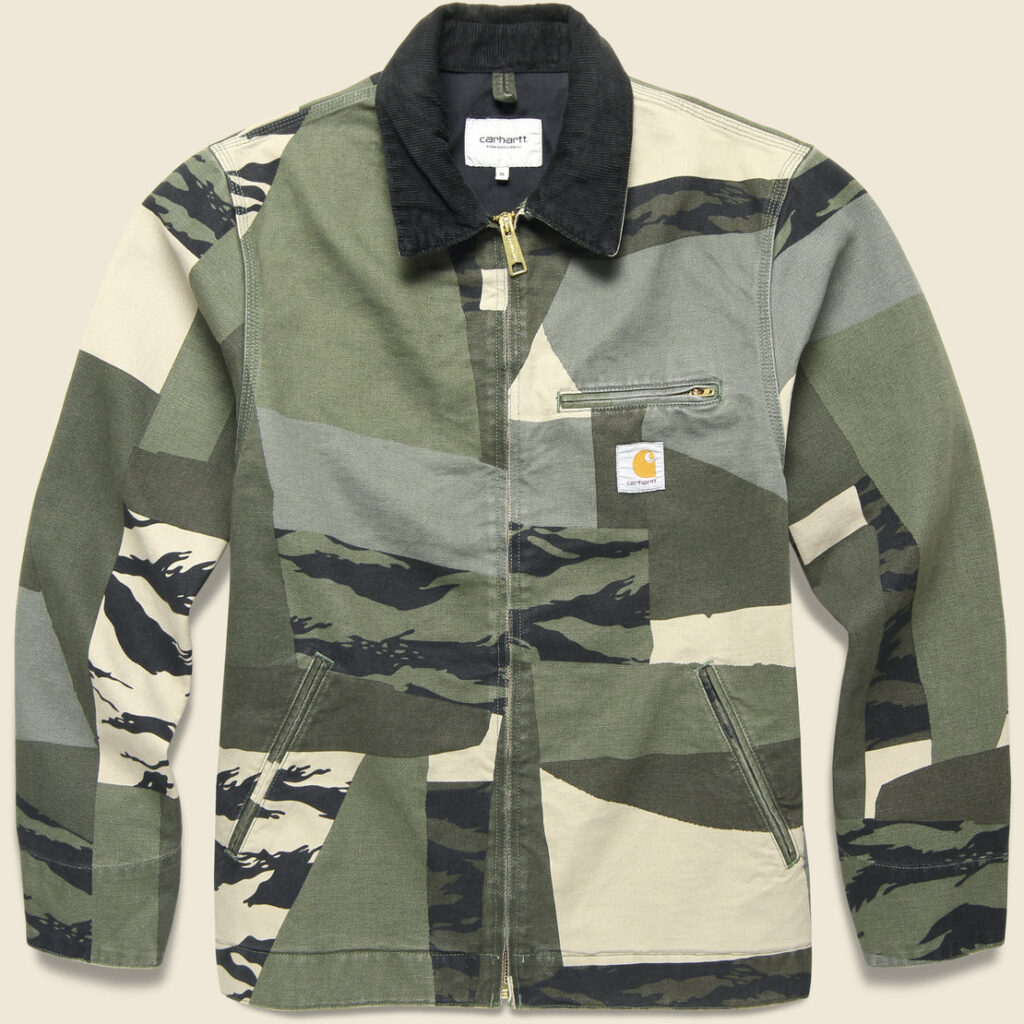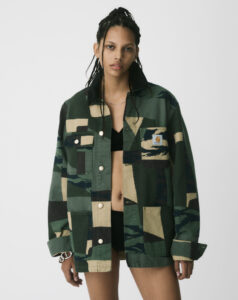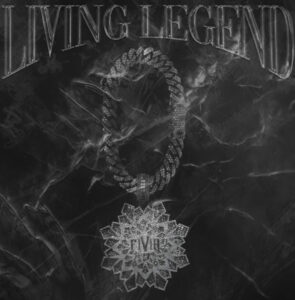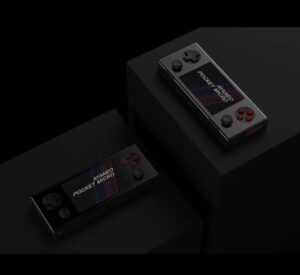JACKET / Carhartt WIP
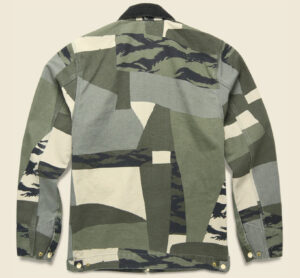
In a cultural moment marked by duality—economic tension meets hyper-individualism, modesty meets performance—Carhartt WIP’s latest design offers a garment that is both shield and signal. Its very pattern, camouflage, traditionally intended to obscure and protect, becomes here a form of amplification.
Carhartt WIP: Heritage in Rebellion
Founded in Detroit in 1889, Carhartt was built on American grit. Its heavy-duty pieces were made for railroad workers, mechanics, and welders. But Carhartt WIP (Work In Progress), the European-born diffusion line, has since subverted its blue-collar DNA, colliding it with subcultures from Berlin’s warehouse clubs to Tokyo skate crews. In 2025, this collision has reached full maturity.
This jacket is a masterclass in contradiction. The canvas is heavy, cut generously, its dimensions swallowed in masculine overstatement. Yet it is styled on a female body with nothing but minimal lingerie beneath. The result is a tension that reverberates. It suggests both protection and exposure, resistance and reclamation. Carhartt WIP, through the cut and fabric of this piece, tells a story about uniforms no longer belonging to the institutions that birthed them.
Camouflage as Code: From Militarism to Multiplicity
The patchwork camouflage on this jacket—muted forest greens, deep blacks, khaki punctuations—is more than aesthetic reference. It is linguistic, a code that viewers must unpack. Traditionally used in military applications to obscure bodies and make soldiers disappear into their environment, camouflage here is deployed in reverse. It insists on presence.
By placing camouflage within an editorial context—especially one that exposes the model’s body in contrast—it becomes a declaration: I am here, unhidden, unbothered, unconcerned with approval. The act of wearing a pattern designed to erase while styling it to accentuate skin is a layered performance. It’s not merely fashion—it’s visual polemic.
Shape and Absence: Oversized as Assertion
The jacket is cut long and wide. It hangs like a protective shell. The sleeves are oversized, the hem drops well below the hip, and the collar, wide and heavy, mirrors the structure of traditional workwear. Yet this isn’t a garment weighed down by nostalgia. It floats slightly, made lighter by the absence of layering beneath.
The underexposure of the body—the bra, the stretch of midriff, the flash of thigh—serves as visual friction. The jacket doesn’t cover so much as it frames. And in this framing, the viewer is drawn not only to the garment but to the space between fabric and flesh, between industrial texture and human vulnerability.
This is not accidental. In 2025, oversized garments have shifted from trend to cultural rhetoric. No longer just a nod to streetwear, they now articulate a refusal of restriction—physical, gendered, social. To wear something too large, too rugged, too coded as “masculine” is to assert one’s right to exist beyond tailoring.
Editorial Composition as Protest
The stark white backdrop of the image offers no context. There is no environment, no narrative architecture, no props. The focus is total. This allows the jacket—stitched in fatigue, dripping in cultural signifiers—to dominate. But this dominance is gently unraveled by the presence of the model herself.
Her hair is braided—tight, deliberate, unstyled in the traditional sense. Her eyes are direct. No cosmetics veil her expression. This is not a glossed fantasy of femininity. It is a document of refusal. And through that, it becomes something more intimate than glamor: a portrait of emotional autonomy.
The choice to pair a jacket so deeply encoded in masculine labor with barely-there lingerie is not one of titillation—it’s of rupture. It asks: Who owns these garments? What labor are they referencing now? What happens when softness inserts itself into spaces built for hardness?
The Economy of Details: Carhartt Tag as Symbol
Zoom in, and the Carhartt logo stitched onto the chest pocket suddenly feels enormous. It’s a modest label—tan background, block letter C—but in the visual economy of the image, it becomes a kind of flag. Not of brand allegiance, but of inheritance. The wearer is inheriting not only a garment but a lineage of utility. The label affirms this as something real, rooted, and resilient.
Carhartt’s logo here does what many luxury logos fail to do: it doesn’t promise status, it promises function. And function, in the context of style, is now its own form of aesthetic rebellion.
The Feminization of Function: A 2025 Narrative
In years past, streetwear’s embrace of workwear often leaned into masculine posturing. But 2025’s aesthetic narrative is shifting. Function is being feminized, queered, and de-weaponized. It’s not that toughness is being abandoned—it’s being redefined. A jacket like this, placed over bare skin, becomes a second skin of a different kind—not one that hides the wearer, but one that reframes their form.
This signals a powerful cultural transformation: where once function belonged to labor and protection, it now belongs to expression. To emotion. To refusal. In a fashion world bloated by excess, garments that were once purely practical—like this Carhartt WIP piece—become intellectual armor.
Flow
This editorial does not pretend to offer escapism. It is not fantasy. It is hyper-reality, distilled into camo cotton and white buttons. The Carhartt WIP jacket, by design, references labor. But through styling, setting, and bearing, it transcends the literal.
It becomes a metaphor for survival, for choosing what to carry and what to expose. It becomes fashion as theory, as commentary, as tension. And it reminds us that in 2025, the most potent looks are those that withhold nothing—but protect everything.
No comments yet.

